The 2024 Edition of Kill Team has overhauled the game, changing rules, datasheets, and bringing with it an updated set of rules for every team in the game. In this series we’re taking a look at each team, how they’ve changed, and what it means for how they play in the new edition.
Intercessors were hugely popular when they were added to Kill Team 2021. They shot to being the most popular team in the world, as the rules were free and available online, everyone and their grandma has intercessors somewhere, and it’s an elite team so there isn’t as much to paint. They were pretty good; good enough to the point GW had to come back and nerf them.
Strike Force Justinian was the Space Marine Heroes Series 4 box. These were given Kill Team cards in the boxes, and if you collected the full set you had the full set of ploys on the back. GW later FAQ’d these to have archetypes so they could be played in normal Kill Team. The team had strong concepts and was much more interesting than the intercessor team, but limited availability of Space Marine Heroes sets (which sold out almost instantly), the delay for them getting rules to be used in normal play, and not being anywhere near as good as some of the other elite teams meant they didn’t see huge amounts of competitive play despite having great models.
Angels of Death takes these two teams and joins them together. It’s the ideal faction for someone with a Space Marine collection to raid from, or who bought the Space Marine Heroes Series 4 box, or who has some intercessors knocking around and wants to play a casual game of the new Kill Team.
It deals with my complaints about the Intercession Kill Team (a lack of specialists and meaningful choices0) and gives you an expanded roster with three possible leaders and six warrior choices, including a heavy weapon/sniper option.
Before we dive in, we’d like to thank Games Workshop for providing a preview copy of these rules for review purposes.
The Video Version of the Review
We have a video version of this review courtesy of Can You Roll a Crit?
Team Structure
An Angels of Death Kill Team has a choice of three leaders, and can pick one.
- Assault Intercessor Sergeant
- Intercessor Sergeant
- Space Marine Captain
It has a choice of six operatives, and can pick five.
- Assault Intercessor Grenadier
- Assault Intercessor Warrior
- Eliminator Sniper
- Heavy Intercessor Gunner
- Intercessor Gunner
- Intercessor Warrior
You have to choose between the Eliminator Sniper and Heavy Intercessor Gunner, but otherwise it is only one model but unlimited warriors.
The load out restrictions are the same for the Intercessors as before, so the Assault Intercessor Sergeant can only have a chainsword if they have a plasma pistol, but if you had a full Intercession team roster before then three additional models gets you a full roster for Angels of Death.
The archetypes are Security and Seek and Destroy, so your secondaries will be biased towards killing things.
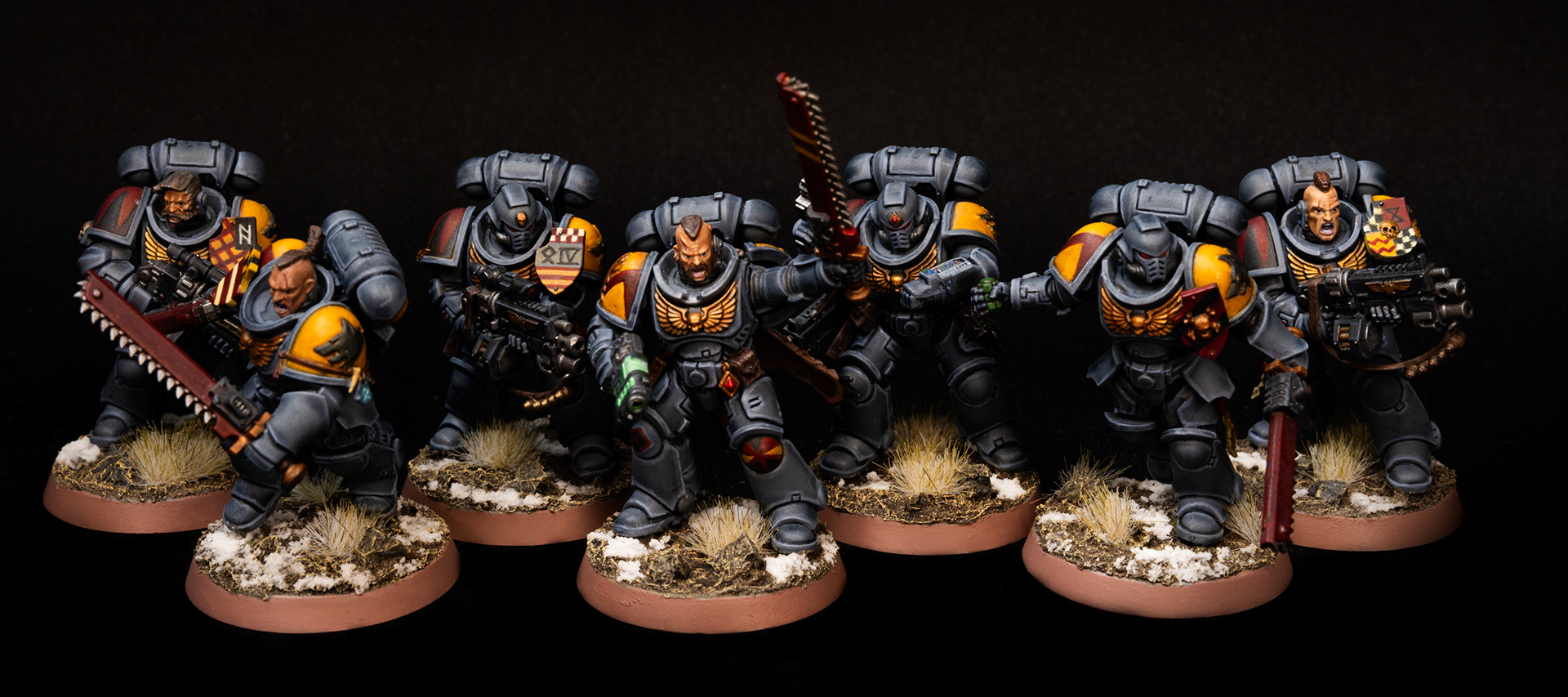
Strengths
Big Boys: Everyone has 3+ power armour. It means you’ll get, on average, two successes every time you roll your defence dice. Everyone except the sniper has at least 14 wounds, and that’s a lot to chew through in Kill Team. So you have big boys who can fairly easily beat up human equivalents 1-2-1.
Big Guns: Even the humble bolt rifle or heavy bolt pistol is a 3/4 weapon with Piercing Crits. These will reliably nail 7 wound models, and clean up hordes. Auto bolt rifles are Torrent 1″ now, so your opponent will need to learn not to bunch their models up. Then you have bolt sniper rifles, heavy bolters and auxiliary grenade launchers to choose from.
Weaknesses
Low Model Count: All elite teams suffer from this, and as soon as you lose 2-3 models it really limits what you can get done in terms of objectives and winning the game. It also means there’s only so much you can do, and your opponent Leroy Jenkins-ing into one of your models and killing them hurts you a lot more than it hurts them. Essentially all the difficulties the team have stem from you only having six models, making board control harder. You don’t roll as many dice as your opponent, so a few bad rolls hurts you more (a lot of the ploys and equipment are to mitigate this).
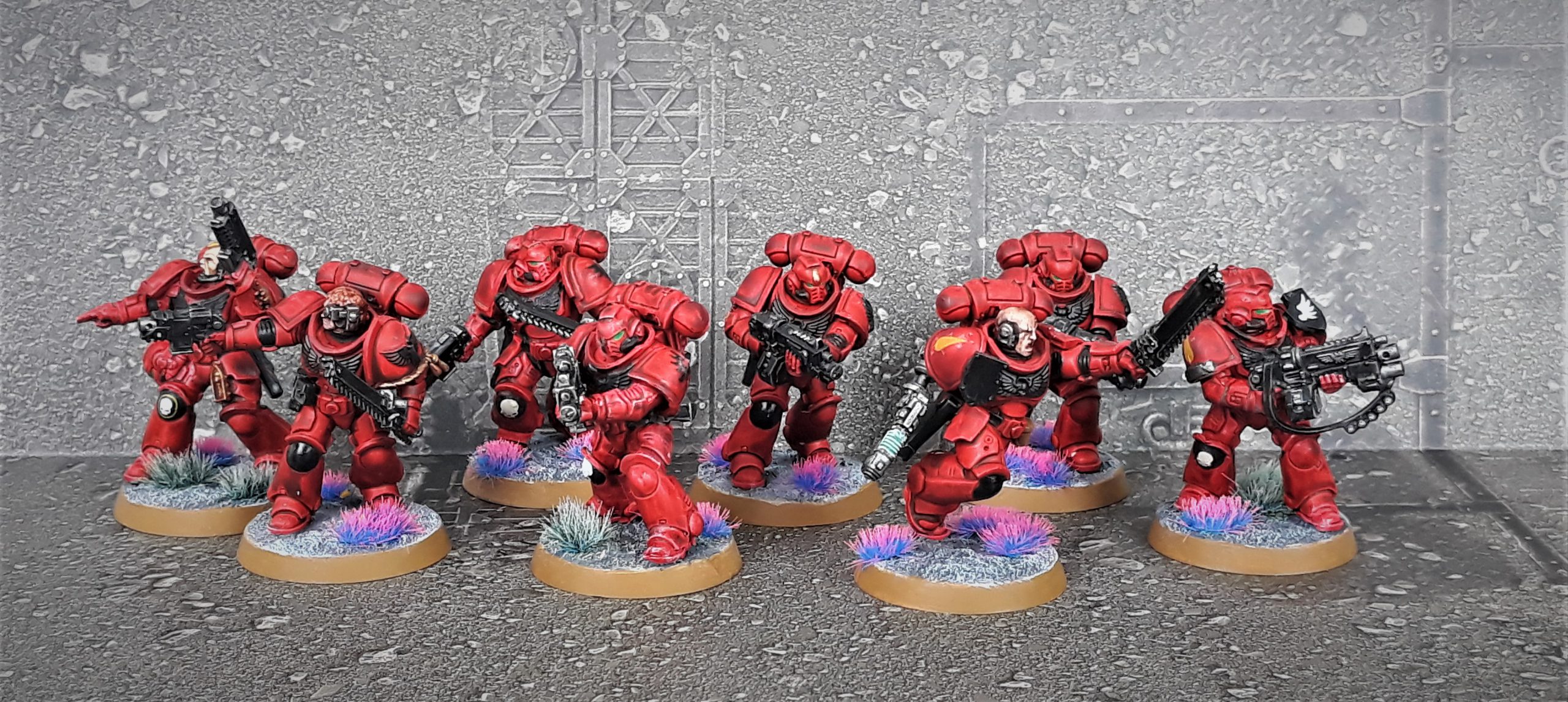
Faction Rules
There are two Faction Rules, Astartes and Chapter Tactics.
Astartes
Angel of Death operatives can perform two Shoot or two Fight actions during their activation. If it is two Shoot actions, one Shoot action must be performed with a Bolt weapon. If the second Shoot action is with a Heavy Bolter or Bolt Sniper Rifle, then the second Shoot action costs an additional AP if both actions use that weapon.
Angels of Death operatives can Counteract regardless of order.
This is great, and bakes in the double Fight/Shoot of the previous edition without tying it to specific models. Everyone can do it. Your rifle marine gets into combat with two cultist mooks? Guess who’s punching them twice.
Chapter Tactics
Chapter Tactics have changed. You still pick two, but there are less to choose from and they have thought about balance more. Chapter Tactics were the most controversial part of the Intercession Team, and saw the most changes, so it’s no surprise they have been substantially revised. They’ve reduced the number to choose from to eight, and made them all good to reasonably useful.
You select a Primary and Secondary Chapter Tactic, and this is important because one Strategy Ploy lets you change your Secondary for a turn, so for instance if you are going to be shooting a lot of enemies in cover you could change to Siege Specialist for a turn, if you are going to be doing a lot of charging you could pick Dueller, etc. It makes Chapter Tactics really flexible.
Aggressive
The operatives melee weapons have the rending rule.
Great if you are going with a more melee focused force. A critical success means turning a normal success into another critical, and the captain and assault intercessors are all rolling 5 dice, making a crit fairly likely.
Dueller
In a Fight one of your unresolved normal successes can block an unresolved crit or one of your unresolved crits can block two normal successes.
If you are resolving first this lets you block a lot, possibly all, of the damage coming back at you. This can be taken as well as Aggressive, to turn your kill team into melee monsters. It would be overkill against most enemies though, but sometimes overkill is the best kind of kill.
Resolute
Ignore any changes to operatives APL stat.
There are a number of Stun weapons and ploys out there that reduce APL, this means you just ignore them.
Stealthy
When an enemy is shooting your operative, if you can retain a cover save (for instance from being in cover) you can either retain two normal saves or retain one critical save.
Kill Team is a game where there is a lot of terrain on the table, and a lot of cover to hug.
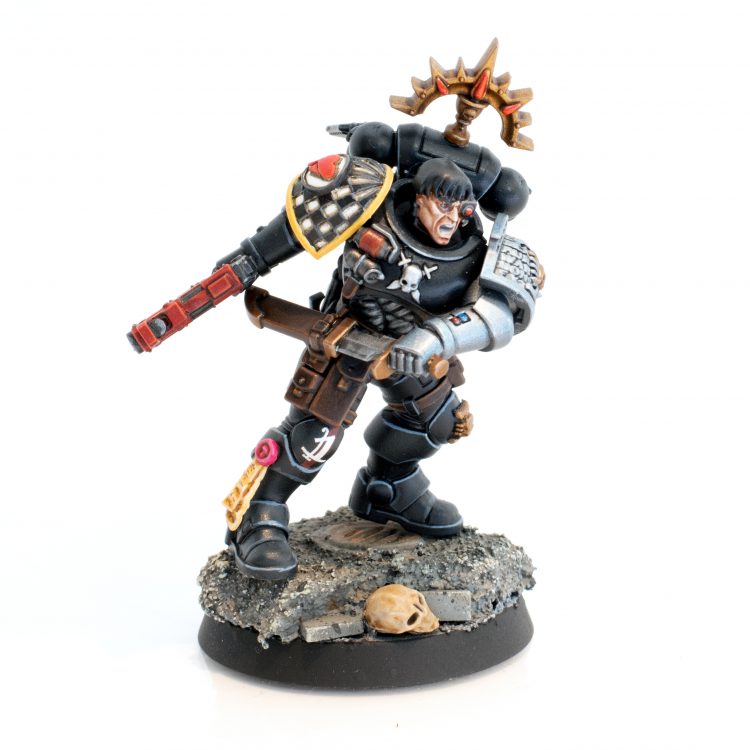
Mobile
Fall Back action costs 1 less AP and you can Charge while in an enemies control range and leave that control range while doing so.
This means you can leg it out of combat toot sweet, even charging a different opponent to leave a combat. This means you can basically never be pinned down, and if your opponent charges you with their big mean melee thing you can nope out of there during your activation, possibly into some squishy boy who’s an easy kill.
Hardy
When rolling defense dice, 5+ is a critical success.
This was taken a lot in the last edition for obvious reasons, because making a critical save is pretty useful.
Sharpshooter
When the operative makes a Shoot action in a turn when it hasn’t performed the Charge, Fall Back or Reposition action, it’s bolt weapons gain the Severe rule.
Severe means that if you don’t roll a crit, you can change a normal success to a crit. So if your weapon has Piercing Crits, like heavy bolt pistols, bolt rifles, stalker bolt rifles and heavy bolters do, it makes getting -1 defense dice much more reliable (you have to miss with every dice not to get it, and if you’re stood there rolling 4 1s and 2s regularly then maybe dice games aren’t for you).
Siege Specialist
The operatives ranged weapons gain the Saturate rule.
Severe means targets in cover don’t automatically retain a defence dice, which is pretty nice given a sensible player has their operatives in cover as much as possible, and low save horde teams benefit from cover more than power armoured Kens do.
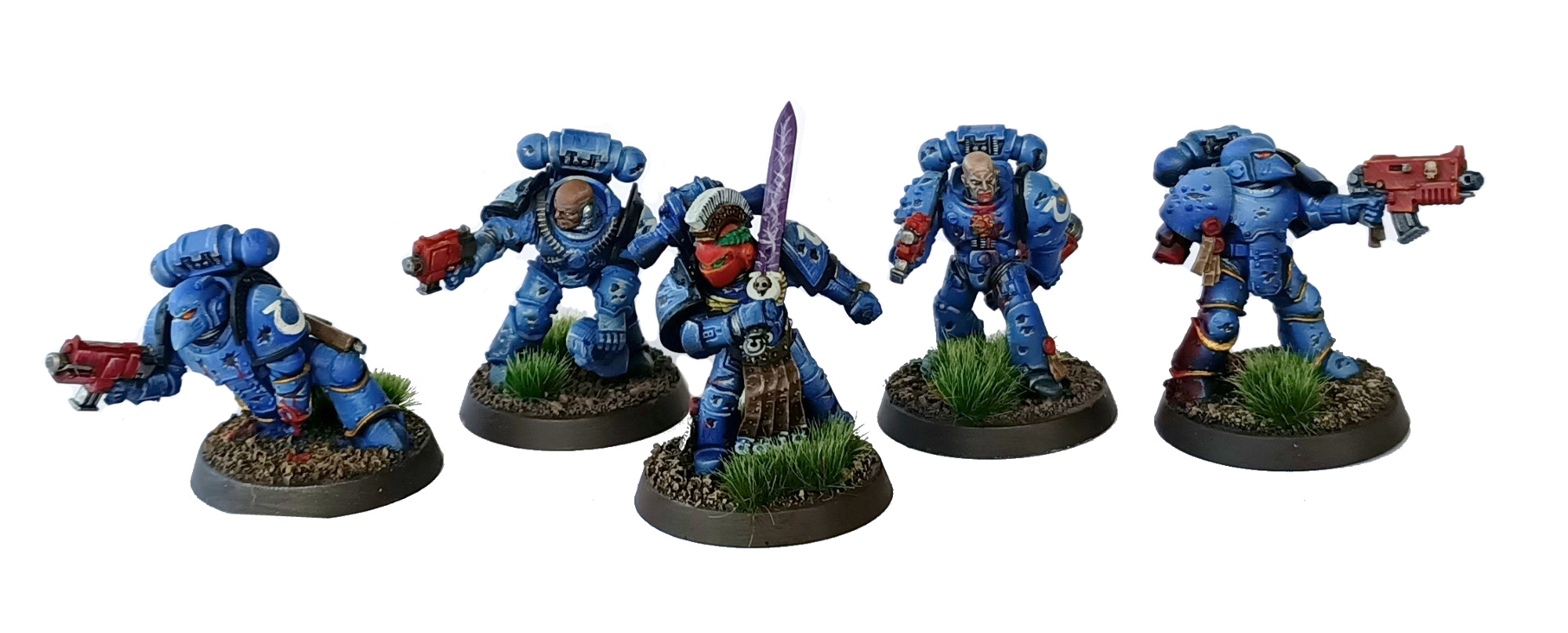
Strategy Ploys
Angels of Death has some strong ploys for taking out the swinginess inherent in having less operatives rolling less dice, and a couple of other useful ploys.
Combat Doctrine
Select a Doctrine, and your operatives get Balanced (a reroll) on their weapons in that situation.
- Devastator – shooting at targets over 6″ away.
- Tactical – shooting at targets within 6″.
- Assault – Fighting or retaliating.
This is the ploy you’re likely to use every turn. You only get so many dice, and even if you generally roll 3+, you’ll get some 1s and 2s. It’s a great ploy to increase the number of successes, especially when you start busting out Torrent weapons and get a reroll for each target.
And They Shall Know No Fear
Ignore any changes to your operatives stats from being injured, including weapon stats.
Great for the last turn when your whole team have taken some ouchies but you don’t want the negatives that go with it.
Adaptive Tactics
Until the end of the Turning Point, change your secondary chapter tactic to a different one.
This is why choosing your primary and secondary tactics is important. It means that in a turn where your marines are getting stuck in you could flip your secondary to Dueller or Aggressive, in a turn where the enemy are all in cover you could flip to Siege Specialist, etc.
Indomitus
If you roll two or more failures in a Shooting action, discard one and change another one to a success.
Note that this will prevent you using the balanced rule if you only had two fails. Unless you’ve got a lot of injuries or just have the worst dice ever, then Combat Doctrine is the way to go.
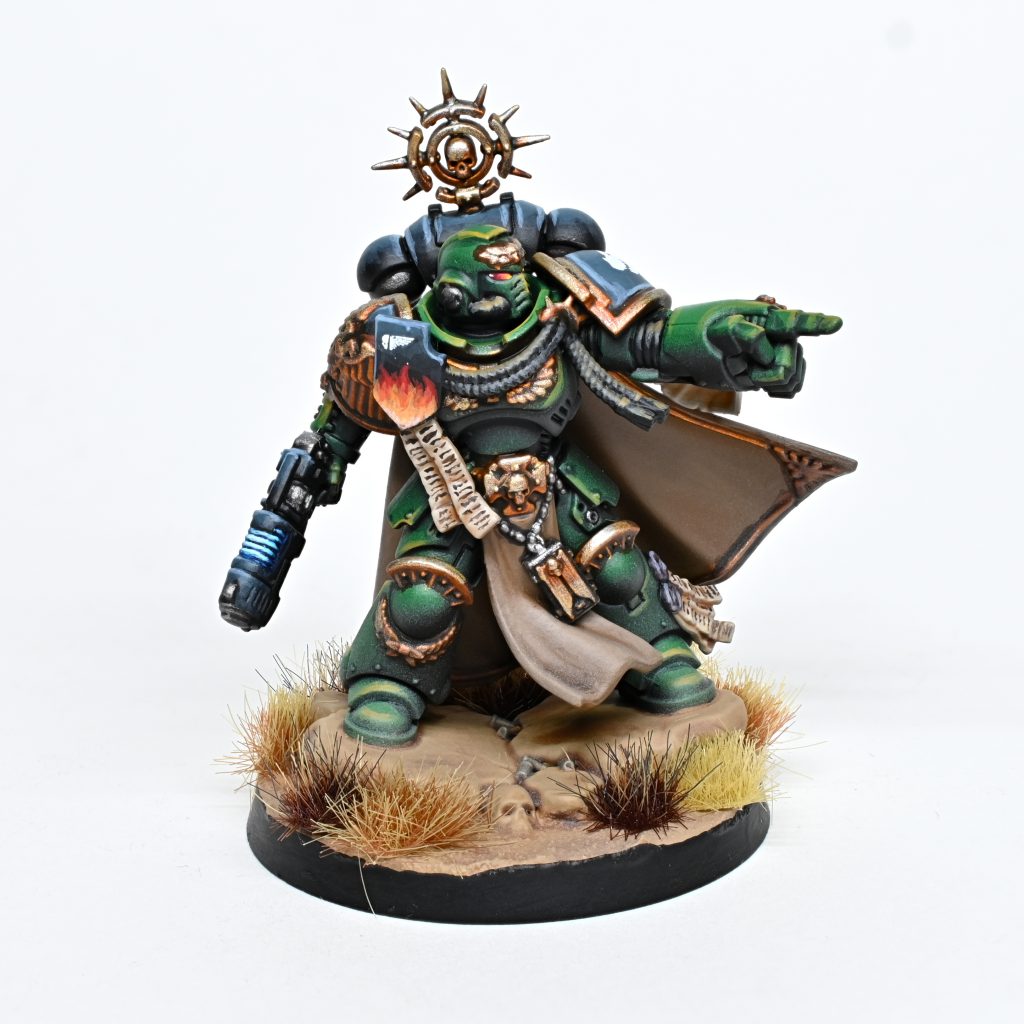
Firefight Ploys
Adjust Doctrine
If you used the Combat Doctrine strategy ploy this turning point, you can pick a different doctrine.
This changes it for all your models till the end of the turning point, so if you selected Devastator, fired your models shooting at long range, you can then switch to Assault when your captain or whoever is charging in. This makes Combat Doctrine even better as you can switch it during the turn based on what’s happening in the game.
Transhuman Physiology
When a friendly operative is being shot at, in the roll defence dice step, you can retain a normal success as a critical.
For when you’re going to take a critical hit and you really don’t want to.
Shock Assault
When a friendly Angels of Death Operative is performing a Fight action in an activation where it performed a Charge action, its melee weapons gain the Shock rule and the first time you strike you do an additional damage (to a maximum of 7).
This beefs up everything except powerfists, in particular power weapons which with Lethal 5+ do generate crits on average rolls. It can take a fairly even fight and tip it your way, or turn an uneven fight into a one sided beating.
Wrath of Vengeance
Use when a friendly Angel of Death operative is counteracting; it can perform an additional 1AP action, but both actions must be different.
Using CP to squeeze even more actions out of your operative. In some situations incredibly useful.

Operatives
The team now has an additional leader and choice of two operatives (Eliminator Sniper or Heavy Intercessor Gunner). The choice between the leaders is significant, and all receive different bonuses.
Space Marine Captain
The Captain comes with a plasma pistol and powerfist, a combo you can’t get on another model, and has 3+ to hit on the powerfist. Iron Halo allowing you to ignore a normal damage once per game effectively gives you 18 or 19 wounds, and Heroic Leader lets you either use a Firefight Ploy (except for the reroll one) on the model for 0CP, or use the Adjust Doctrine ploy for 0CP each turn.
So he’s a big beefy close range puncher who’s really good in a fight and effectively gives you an extra CP a turn.
Assault Intercessor Sergeant
What does the Assault Intercessor Sergeant do that the captain doesn’t? Let’s you take a Thunder Hammer or Power Fist and a Hand Flamer, which some players really like on enclosed maps like the Gallowdark ones.
Doctrine Warfare means that you can select Combat Doctrine and if you select Assault or Tactical then it costs 0CP. This actually makes the Assault Intercessor Sergeant a strong contender for leader on Gallowdark maps, where you will want to take the Assault or Tactical Doctrine each turn and a flamer can be pretty handy. Chapter Veteran lets you take a third chapter tactic for the model, and if you haven’t taken Dueller then it’s a good choice.
Intercessor Sergeant
The Intercessor Sergeant can take any of the bolt rifles with any of the power weapons, which gives you a big mean melee threat that still has long range firepower. They have the same additional rules as the Assault Intercessor Sergeant (Doctrine warfare but choosing Devastator or Tactical, and Chapter Veteran) and it’s an option when playing on open maps where there is more time for long range fire. I think they’re the weakest of the sergeant options, but there’s a place for it in the roster.
Assault Intercessor Grenadier
An assault intercessor warrior with free frag and krak grenades. A compulsory pick given you’ll generally want an assault intercessor for melee threat and a couple of free grenades is a couple of free grenades.
Assault Intercessor Warrior
Your basic melee operative, this Astartes runs round with a heavy bolt pistol (so still 3/4 Piercing Crits 1) and a 5 dice, 3+ to hit, 4/5 damage chainsword. So if you resolve a crit and hit you’ve blendered a 9 wound model in two strikes.
It’s like he’s built to terrorise most kill teams’ basic profile. Great on close engagement maps like Gallowdark, and where there’s terrain for them to advance behind before jumping out and chainsawing things to death.
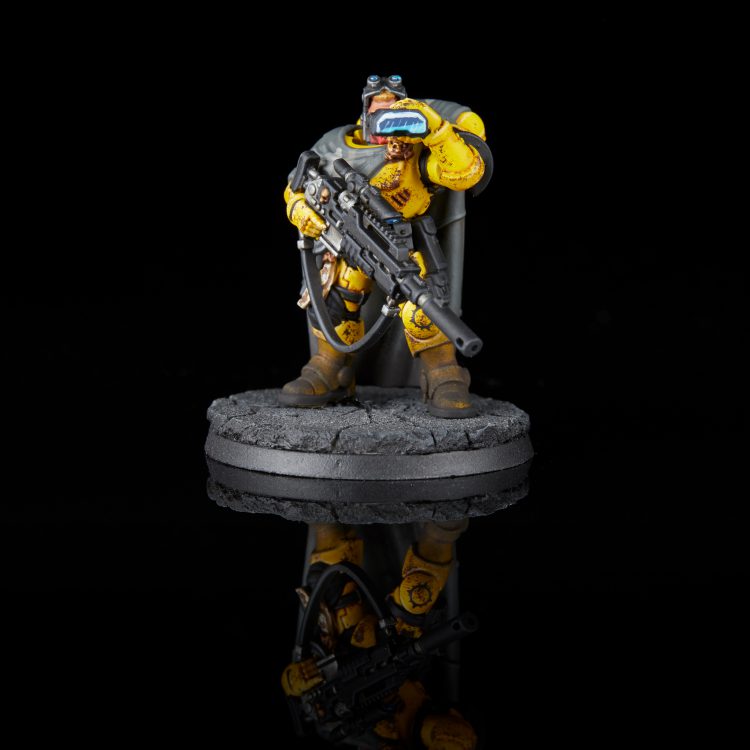
Eliminator Sniper
A new and welcome addition gives you a sniper with a selection of rounds for crowd control, getting through cover or just making something very dead. The Camo Cloak means you can always retain a save while in cover (2 if you use the Stealth Chapter Tactic) and you have access to the Optics action that means a target cannot be obscured (though if you use this you can’t fire twice).
12 wounds, a 3+ save and a 7″ move means you have one of the fastest and toughest snipers in the game and the Silent rule on the Sniper Rifle means you can always sit in Conceal while blowing the heads off any target that comes into sight.
I like the rules for the Eliminator better than the Heavy Intercessor Gunner, and it loves open maps.
Heavy Intercessor Gunner
Big, tough and slow, the Heavy Intercessor Gunner is the opposite of the Eliminator. GW have changed the Heavy Intercessors in exactly the way everyone was recommending in the previous edition, giving them 3 APL but only a 4″ move, so it can’t zip around the board but with a Heavy Bolter, 3+ save and 18 wounds if you can get it in a good firing lane it can hose down anything in range.
Heavy bolters have changed to having two firing modes, focused and sweeping, and sweeping drops you to 4 dice but gives you Torrent 1″, so if you see two 7/8/9 wound 5+ save models next to each other, you know what to do.
Intercessor Gunner
A standard Intercessor Warrior with an auxiliary grenade launcher as well, this again is a pretty much compulsory choice as a back stop model that can throw a 2″ blast of a 4/5 piercing 1 shot down range. With Astartes getting two shots a turn you can fire your grenade launcher and bolter in the same turn.
Intercessor Warrior
Your standard ranged operative, the bolt rifle (or auto bolt rifle) are both solid choices that do work, though if your opponent sees you toting auto bolt rifles, and auxiliary grenade launcher and a heavy bolter they’d be daft to have models within an inch of each other.
An incredibly solid trooper with a good gun and even with fists the ability to pop the heads off 7 wound models fairly reliably in fights.
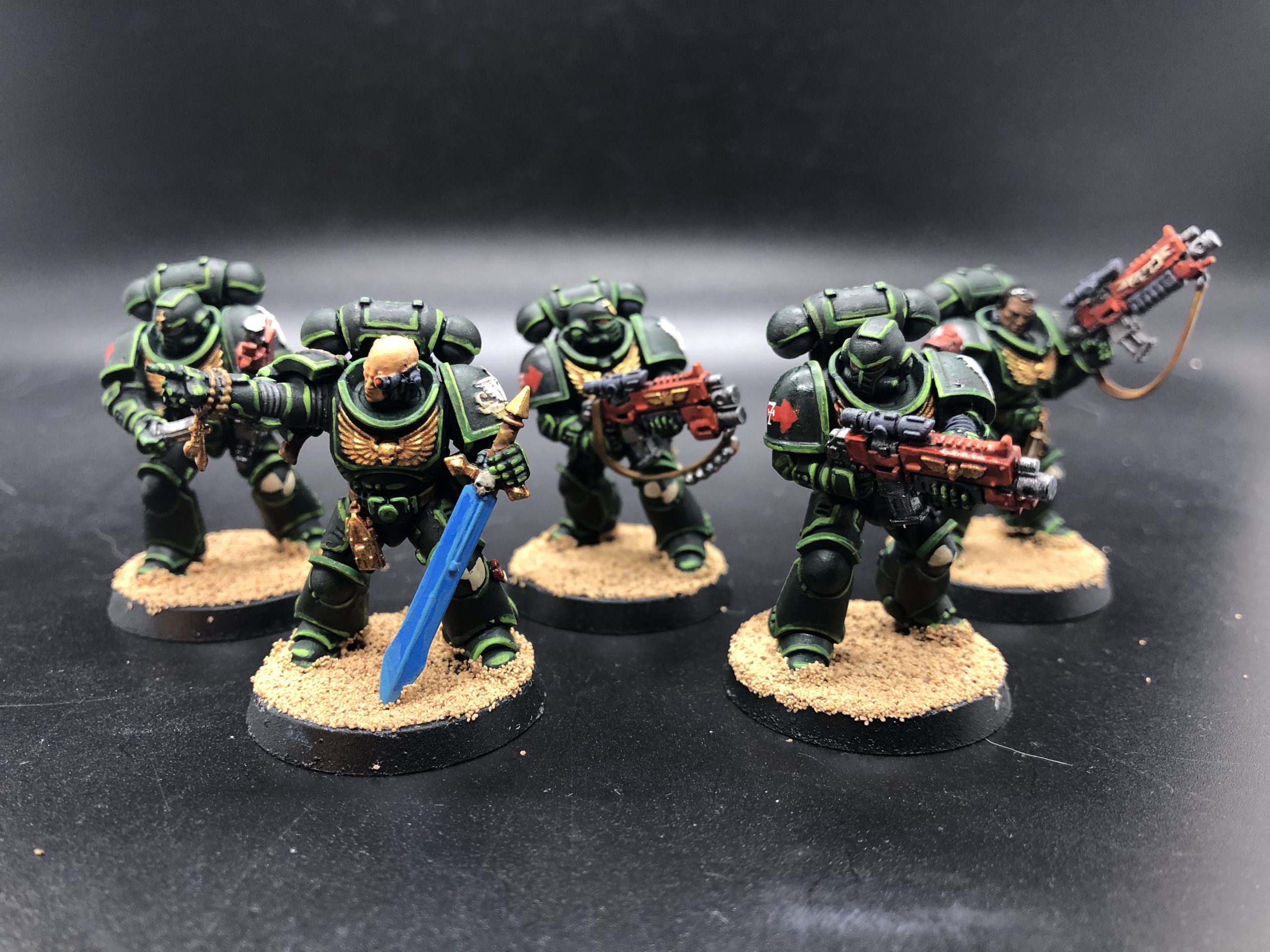
Equipment
Purity Seals
Once per turning point, if an Angels of Death operative is Shooting, Fighting or Retaliating, if you roll two or more failures, you can discard one and change one to a success.
So it’s a better version of the Indomitus Strategy Ploy, but only for one model a turn. It helps mitigate bad rolls, but bear in mind it may mean you can’t use Combat Tactics as there’ll be no failure to reroll due to Balanced.
Chapter Reliquaries
You can use the Wrath of Vengeance Firefight Ploy for 0CP if the model has the engage order. So potentially six free actions a turn. Incredibly good.
Tilting Shields
Once per turning point, when a friendly Angels of Death operative is fighting or retaliating, then after your opponent rolls their attack dice you can say that only sixes can be retained as crits.So Lethal, Severe and Rending are essentially nullified and you get to pick when it applies.
Auspex
Once per turning point, when a friendly operative performs a Shoot action and you’re selecting a valid target, you can use this rule. Enemy operatives within 8″ of the friendly operative cannot be obscured until the end of the activation/counteraction.
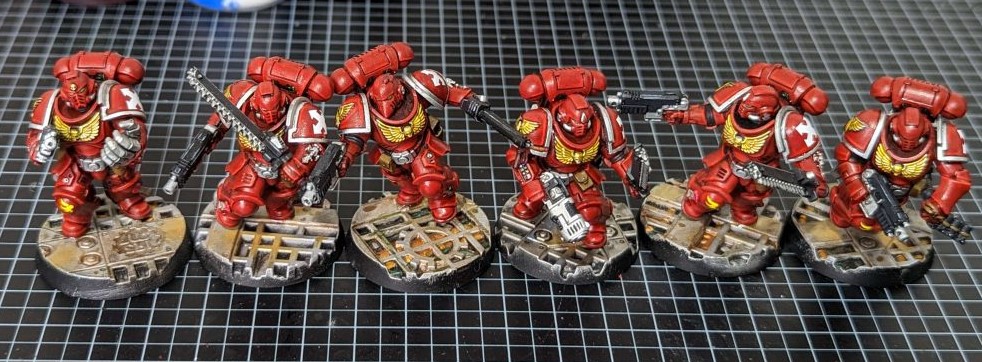
Suggested Roster
Ideally you have a Strike Force Justinian sitting around, and can combine it with a couple of Intercessors and Assault Intercessors and a couple of sergeants. If not then you need to pick up a few singles (Eliminator, Heavy Intercessor Gunner, Captain) in addition to five intercessors and five assault intercessors to have a full roster.
- Space Marine Captain
- Intercessor Sergeant – Bolt Rifle, Power Weapon
- Assault Intercessor Sergeant – Hand Flamer, Power Fist
- Assault Intercessor Grenadier
- 2 x Assault Intercessor Warrior
- Eliminator Sniper
- Heavy Intercessor Gunner
- Intercessor Gunner – Bolt Rifle, Auxiliary Grenade Launcher
- 2 x Intercessor Warrior – Bolt Rifle
- 2 x Intercessor Warrior – Auto Bolt Rifle
This gives you a really flexible roster that can go melee heavy or shooting heavy or balance between, and can pivot to be anti-horde with lots of Torrent auto bolt rifles or more general purpose with bolt rifles.
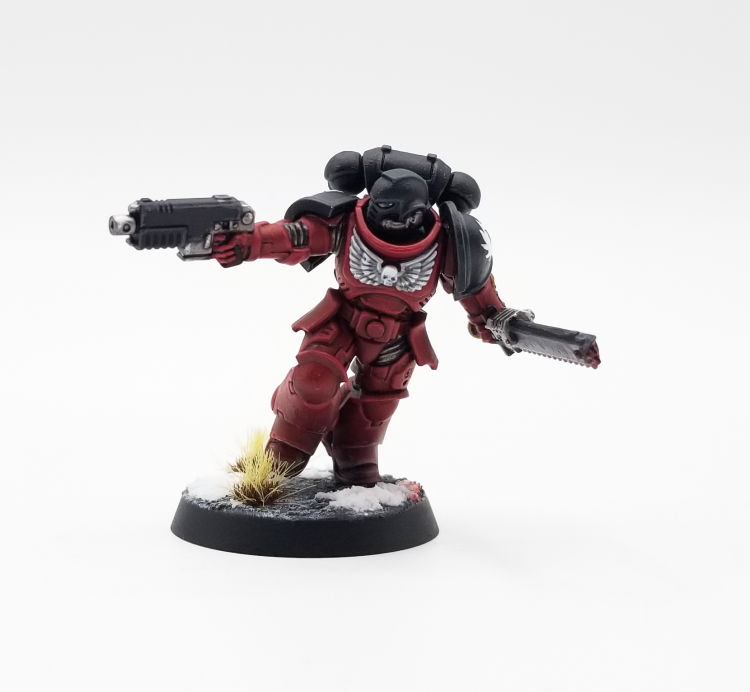
Final Thoughts
This is going to be one of the most popular kill teams in the game because it’s Space Marines, because lots of people will already have the models painted and because it’s a small elite team that is reasonably easy to play.
It’s a solid team, more interesting than the previous Intercession team, and with a lot of ploys to make the performance of individual models more consistently good.
You’ll be outnumbered fairly often, but that’s where Space Marines should be, carving their way through Dave Dirtfarmers who were unhappy with the crushing oppression of the Imperium and didn’t understand that Chaos liberating you from that came with quite so many extra tentacles.
I think GW missed the opportunity to add an Infernus marine as an option, given that’s the free in store miniature for the current edition and in all the starter sets . It could compete with either the Eliminator/Heavy intercessor Gunner or the Intercessor Gunner for a slot, so for example you choose between the Infernus Marine or the Intercessor Gunner so the Intercessor Gunner isn’t an automatic pick.
In design terms the team is solid, paring down the Chapter tactics options while making mixing and matching the selection more flexible. The ploys are mostly about removing dice variance, and in a small model count team this increases the reliability of what are, essentially, a group of individual models.
The team is fairly straightforward to play, and doesn’t rely on the complex synergies that some teams do (looking at you Novitiates). In many ways it’s similar to the Compendium Custodes of the previous edition, with big beefy guys running around punching things and the ploys all about making them more efficient at doing that.
This team is going to likely see the most analysis and attention in the competitive format, because it will be so popular that strategies to win with it and beat the snot out of it will be major topics of discussion in the wider competitive community.
In modelling terms I think we’ll see some great teams given the blank canvas marines give for creativity in both conversions and paintjobs, and we’ve already seen heavily converted teams in the official GW publications.
It’s a great day to be a brainwashed gene-enhanced child soldier.
Have any questions or feedback? Drop us a note in the comments below or email us at contact@goonhammer.com. Want articles like this linked in your inbox every Monday morning? Sign up for our newsletter. And don’t forget that you can support us on Patreon for backer rewards like early video content, Administratum access, an ad-free experience on our website and more.


